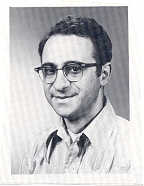
There was once a little kid in Minne- apolis who liked
to watch birds and collect rocks and fossils. He liked
to read about the universe around him and fiddle with
gadgets, and since his two older brothers were scientists, he said that
he, too, wanted to be a scientist when he grew up. That kid grew up to
be me.
My major interests centered around genetics and evolution until I met some fine teachers at the University of Minnesota who got me excited about other things. I studied philo- sophy, especially philosophy of science, and I met biologists who were interested in much more than their own fields. Grover Stephens took me off to Woods Hole as a technician, but what I learned there was much more important than the invertebrate physiology going on in his lab. At Woods Hole I first heard and saw the people I had read about in books and journals; I saw how good science is really done, and I began to see science as a social phenomenon, as a process in which bright and lively people talk and work and play with each other in their search for an understanding of the world. At Minnesota I felt like a colleague of the zoology faculty, rather than a student, and I was allowed to teach in the zoology labs for a year. Life was good, and I was sorry to have it end with a B. A. with an interdepartmental major in 1958.
Since I had decided that embryology was the science of the future, I went to Johns Hopkins. But in my first year there I learned about molecular biology, and when Aaron Novick started the Institute of Mole- cular Biology at the University of Oregon, I came west to join him-- and incidentally search for a New Life, like Bernard Malamud. I found that I had fallent into one of the greatest intellectual adventures of our time, in the company of some of the most exciting people I have ever met. I learned what biology is and how it should be done. For adding a brick or two to the edifice of cellular physiology, I was given a Ph. D. in 1963. Meanwhile, I had acquired a new outlook on life and learning, a cute, warm-hearted wife named Shelley, and a growing passion for teaching biology and writing about it. I went to Caltech to post- doc with Bob Edgar for two years, but I was not much use to him because the lure of teaching and writ~ng was already too great. The University of Kentucky promised to satisfy my needs, but I found that real teaching was not wanted there and that my beautiful science was perverted and hidden from students. Evergreen came along just in time. I hope I will have a chance here to teach what I knowabout and learn a great deal that I don't know; to explore the world with good students; to watch birds, clouds, sunsets, and girls; to be happy.
Burton S. Guttman